- Bernard Preston homepage
- Potatoes
How To Plant Potatoes
How to plant potatoes is for those with a big-garden; and frankly only for organic freaks like me. Commercial farmers use a very toxic herbicide just before reaping to kill the haulm.
I am afraid if you are seriously overweight, you should absolutely avoid spuds because of their high GI.
Unless and here you can take the gap, you can locate new-potatoes because they have a third less starch.
The obese simply must wait and allow their potatoes to retrograde by cooling overnight in the fridge and then enjoying them the next day; and avoid spuds from cold storage altogether.
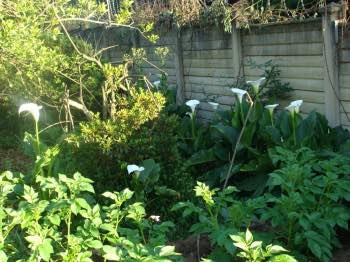
This page was last updated by Bernard Preston on 9th September, 2024.
If you have the strength to dig the trenches then you can certainly enjoy them; exercise after starchy meals means the carbs are turned into glycogen in the liver instead of raising blood glucose and triglycerides.
Here is my patch with beautiful arum-lilies in the background. We grow them every year; there's nothing like your own new potatoes.
If you have no moles
- Dig a trench a spade wide and about a foot and a half deep.
- Add some well-rotted compost, or even old mealie stalks.
- Drop in the seed-potatoes about a foot apart.
- If you have the time and energy plant a bamboo-stick about a metre long next to each potato.
- Cover each seed-potato with a couple inches of soil.
- Heap up the soil around each haulm as it grows.
- Tie them loosely with twine to the bamboo-stick when they start to flop over.
- If necessary add more soil from elsewhere heaping it up as high as possible.
- Start reaping as the haulm dies back; only enough for a day or two.
If you have moles
- Whatever you do, no trenches.
- Dig random holes about a foot deep.
- Add as much compost as you can spare.
- Plant one or two seed potatoes in each hole.
- Press a metre-long bamboo stick into each hole.
- Cover the tuber with a little more compost and continue as above.
Price of potatoes
The price of potatoes has soared to over R12/kg in 2024; it makes a lot of sense to grow your own. We are expecting at least a ton from our green garden this summer; that alone is twelve-thousand rands worth of food.
For three months that we think is a pretty good return. Less than 20% of South Africans grow any food whatsoever; but we hear a lot of whinging about the cost.
Pumpkins and butternut
Pumpkins and butternut often spring up from the compost. If you do not use the bamboo sticks to mark them, I would pull the vines out as the potatoes get lost after the haulm dies back.
A little effort to cut and use the bamboo-sticks may mean you also get a crop of cucurbits from the same patch. It makes it easier to heap up the soil if the stems are lightly tied up; less likely to get blight too.
It is always wise to make too much potato-salad. Even if you are cooking for two, make enough for five. It improves with age; that is, if you are lucky enough to have any left over.
- Laurie Colwin, 1944 - 1992
Much-loved Laurie Colwin died suddenly and unexpectedly at 48 of a heart attack. I have been unable to discover if she was a smoker but a love affair with black and white food, meat and potatoes, is also deadly.
She was spot on about cooking extra and leaving it overnight; it enables retrogradation to occur which inhibits rapid digestion in the small-intestine. That would otherwise cause a blood sugar surge.
Potatoes do keep quite well, so there is not much advantage unless you really want food that has been grown without inorganic fertilisers, poisonous anti-fungal sprays and dessicants to kill the plant just before harvesting; most of the world couldn't be bothered.
Why is it so important? Well, as you no doubt know only too well there is an epidemic of neoplasms and the so-called autoimmune diseases; much is known about them but there is mystery also. We suspect chemicals have a lot to do with it.
Mind you new-potatoes straight from the ground to the pot are without equal, as with all vegetables.
Plus it is just a fun thing to grow your own food; it is quite hard work but very rewarding. And there is a good return financially; each tuber will produce about ten spuds if you heap them up, are lucky and have a good season. I can easily sell our excess for more than double the price of those coming out of cold storage. How to plant potatoes is for everyone with a large garden.
There is quite a lot of controversy about potatoes these days; they have a high glycemic-index. We will get into that lower down.
Plus they are sprayed with very toxic herbicides, Paraquat and Roundup, just before reaping; some of the remnants certainly find their way into our bodies.
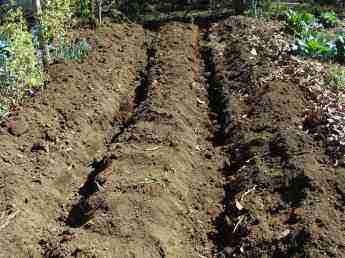
How To Plant Potatoes
How to plant potatoes requires some planning; in particular, think back-exercises. It is hard work digging those trenches and, since this is also a site about wellness, we have to study prevention of lumbar spine conditions and leg pain too.
There is no point if you have to add ten consultations with your DC before you can even start thinking about when to harvest potatoes.
I myself had a serious slipped-disc last year, turning a heavy patient so before picking up the spade, I first spend two or three minutes doing our lower back exercises. That is over and above the set I did before I arose; I do them every morning and you should too if you have had LBP episodes. In fact, like brushing and flossing teeth, I recommend that we all do them daily. That means every single day.
"If I ever survive this hell, all I would want in my life is enough potatoes."
- Auschwitz survivor, Rosalie Simon, now 91.
Just how deep should you dig those trenches? There is a toss up. If you make them two-foot, then the growing plants get lots of support and do not fall over; but then they are a lot more difficult to lift.
A gimmicky way to do that is growing potatoes in tyres but that is not practical on a large scale; we will perhaps have some fun later.
So step-one at how to plant potatoes is to clear some ground; last year there were green peas growing here and I added plenty of compost. That should should be sufficient nitrogen. I might add a row of bush beans between them just to add more of the element. Bacteria in the nodules of legumes fix the gas[4] from the air; some is left for the next generation of vegetables.
Traditional people do interesting things. The American Indians put a fish head and skeleton at the bottom of each hole. Zulus in South Africa use chopped up corn-stalks. The point is that they are heavy feeders and need compost of one sort or another.
Step two is to go and buy a small pocket of seed-potatoes. A pound or two would be adequate if this is your first time.
Try it on a small scale first.
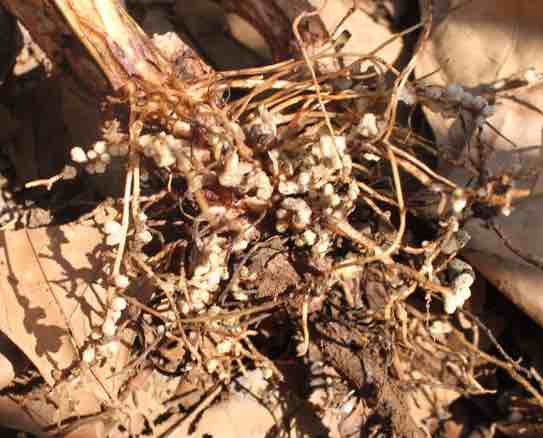
Actually step one is do these little exercises first; they take only forty-seconds.
Step three is to dig your trench; I recommend about a foot maximum. You can go deeper but harvesting potatoes becomes more difficult; on the other hand you will not have to heap up the soil so high.
Place the tubers about a foot apart in the trench, and cover them with a small amount of soil; having said that, this year I had access to cheap seed and put two together. It has proved worthwhile.
I planted these on October 5; normally I would have started earlier once the danger of frost was over but we have had a severe drought this year. Waiting for the first spring rains was important. We began reaping three-months later in January.
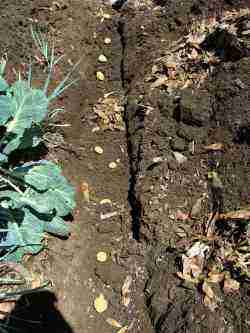
Moles
Moles do the earth a lot of good by tunneling their way underground allowing air to penetrate; they also eat insects lying dormant in the earth, just waiting for spring. But they can do a lot of damage to the potatoes you have planted.
They too love a green-garden devoid of toxic poisons and that uses humus instead of inorganic fertilisers. Unfortunately, if you have a problem with moles, you just must not plant your seed potatoes in trenches; having found the first spud, they will simply move along the row and break your heart. Instead, dig holes here and there as randomly as possible, still about a foot deep.
Progress
Every month or so I will take more photos and track the progress of our growing potatoes. It will be about three-months before we start to harvest.
The potato stem is called the haulm; here they are just up, about three-weeks after planting.

Ridging up the earth to prevent the plants from falling over is important; here they are a month later in flower. I now space them far more widely to make it simpler.
It's a good idea to pour cans of compost over the growing haulm; to keep out sunlight from the young spuds. Then they will turn green; solanine is mildly poisonous.
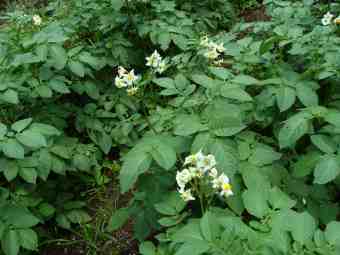
Unfortunately it has been one of the wettest summers I have ever known; many evenings a thick mist envelops our village with a light rain. The potato haulms were hit by a late-blight causing them to die back very quickly.
This knocked the yield quite badly; perhaps the decision not to fertilise played a part too. Next year, over and above the heavy composting, I will consider a little inorganic nitrogen.
On reflection I decided against it; either your garden is organic or it's not. Instead we now plant them after a legume crop; rhizobia bacteria attached to the roots extract nitrogen from the atmosphere.
We love new potatoes; as soon as they reach about the size of a golf ball we will start harvesting them. With about six rows I will have the luxury of the young-spuds as well as the fully mature food.
The quality has been exceptional; the blight has not affected the potatoes at all.
Commercial farmers use various methods to destroy the haulm; this is to satisfy customers who want a particular size. It comes at a price however; chemical dessicants, herbicides, to kill the plant.
We enjoy them large and small. How to plant potatoes to my mind is only worthwhile if you are going organic.
Place your old potatoes in a paper bag and keep them in a dark, cool place until they start shooting; they are perfect for seed.
Potassium
Only one third of the world's population gets sufficient potassium in their diet; and supplements are potentially dangerous so it has to be carefully managed. Highest intake is in Europe where potato consumption is high; and Africa and China are lowest. Americans also have insufficient of the mineral[5].
Low potassium intake especially when associated with high dietary salt is strongly associate with hypertension and cardiovascular disease.
Potatoes are one of the richest sources of potassium.
glycemic index
Glycemic index is a measure of how fast a starch is turned to sugar in the blood stream; alas without plenty of veg and exercise, how to plant potatoes is a recipe for obesity.
Now something about the glycemic index of spuds; the GI of a meal is determined by the mix of carbohydrate, protein and fat; how you cook it, whether it's retrograded and if you can find new potatoes too.
Eating potatoes on their own is not a good idea. They are very rapidly turned into blood sugar, calling for an insulin surge; and that glucose is then stored in all the wrong places. Spuds, on their own, are very fattening.
But in the context of the whole meal, as long as you have some butter, olive oil or gravy on your potatoes, it lowers the glycemic-index; add beans, hummus or a steak and it is better still. Even sour cream will lower the GI.
Never use seed oils with your potato salad, by the way. They are highly inflammatory. Canola is possibly the exception but even there questions remain.
But if you
have a serious weight problem, then you must stick to a maximum of one
potato; or not at all if your body mass index is over thirty. Never eat them hot if you are obese but allow them to retrograde in the fridge overnight.
For more about the carbohydrate count chart and glycemic index follow this interesting link.
Those who spend their energy digging the trenches on how to plant
potatoes have earned the right to eat them. It is hard work; this is
our next season and the spuds are looking fantastic in a much drier
summer. We are irrigating from the rainwater reservoir. Lean and fat years,
it is part and parcel of life.
Read up on it at our rain harvesting model; the end of your water woes.
Potatoes come in for a lot of stick in certain circles; and with some justification.
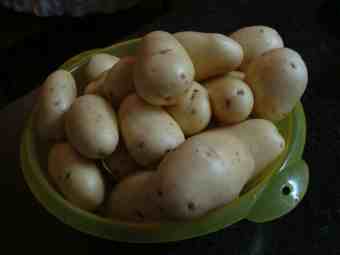
And then of course, you must add your coloured-vegetables if you are to keep the deadly homocysteine levels down; a green such as broccoli for vitamin B6 and a yellow like carrots for the carotenes.
They provide too the fibre so essential for your colon, otherwise rabbit pellets and plenty of straining is on the cards; not good. The normal stool is a long, soft snake; colorectal tumours are not fun.
Banting
Banting has much to offer those with a serious weight problem; that is, emphatically low carbohydrate meals with plenty of fat. Butter is back, but avoid the margarines and common refined polyunsaturate oils that are extracted at very high temperatures. How to plant potatoes is entirely off the radar.
Actually I prefer our modified-Banting way. That means legumes and low glycemic index carbohydrates are allowed; and whole grains too.
If you cut out all fruit and carbohydrates like tomatoes, sweet potatoes and butternut then you will just get a tumour instead.
Are you a couch-potato? Sorry but absolutely no spuds for you, unless you start on this gardening lark; you have to earn your carbs.
If you are overweight and absolutely insist on potatoes, then find out about two important terms; reheating resistant starch, and retrogradation. Perhaps you can have your spuds and eat them after all; just keep the meal portion low.
French-fries are totally off limits; they have a glycemic index close to that of sugar, and are often cooked in old oil that produces toxic aldehydes.
Copy and paste "modified Banting diet" into Site Search in the menu bar above for more information.
Irish potato and leek soup
Now that you have learned how to plant them, it's time to make Irish potato and leek soup, or vichyssoise. With all the fibre in leeks and a dollop of cream to lower the glycemic-index, we can indulge. Digging the trench, heaping up the soil, and reaping the rewards is not for sissies.
One of the oddest things is that in our exhausted, depressed and weary society it is exercise and good food from the garden that gives us so much energy.
Tiredness is one of the symptoms of a mild dose of vitamin B1 deficiency, causing the beri-disease from eating refined white rice. Either change to whole grain or new potatoes.
The good wife gives mathematics lessons for three hours every afternoon, and I treat patients; she plants out broccoli, kale and sweet basil seedlings, whilst I set out potatoes, corn and lima beans.
She makes gooseberry jam on Saturdays, whilst I go gliding all day. I am not boasting but we are nearly seventy and bouncing with energy. If we were children, they would be wanting to put us on Ritalin.
That is a most dangerous drug, by the way, and there are at least ten better things you could do than have teachers insist your busy, vital kids go onto medication.
Oh and we take absolutely no medication. Does that sound good? Turn the TV off and get into the garden, but don't start with a potato patch. Begin with the nutritional benefits of spinach; call it Swiss chard if you will. It is the most rewarding vegetable and goes on for years, unless you live in Chicago.
I know because I did my training in Lombard, Illinois. A life without medication is a real possibility for most folk, if you start early enough with eating the right food and getting plenty of exercise.
How to plant potatoes is for those with a large vegetable garden. Researchers from the University of Maine have shown "higher levels of antioxidants in foods produced under organic practices;" and that spuds grown with plenty of humus and no herbicide pest control are a "healthy food choice."
Braised new potatoes
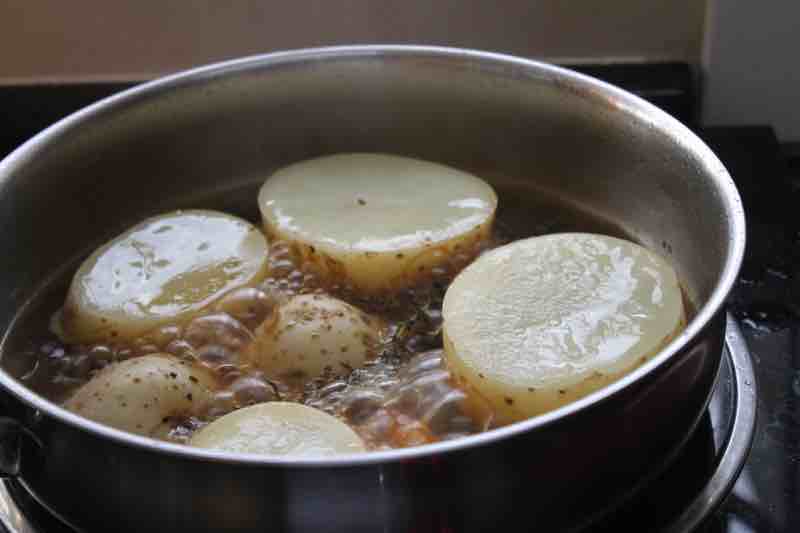
Braised new potatoes in olive oil and a little water gives them a crisp outer skin with delicious soft centres.
This best potato latkes recipe ever can be enjoyed daily; it's not fattening.
An oven-baked dish of mashed potatoes with sauerkraut is another nutritious favourite.
choice foods
Nutritious choice foods is the name of the game; they are what give us plenty of energy and verve. They taste just wonderful, fresh from the garden and we fall into bed exhausted and mostly sleep the night through, without the need for tablets. Never had one in my life; how to plant potatoes is hard work though.
There are so many ways of cooking the potato, hence its worldwide acclaim in cuisine; this traditional Swiss rösti recipe takes a lot of beating.
Seeing I am boasting, I forgot, I am on my seventh book, about the first married pope in a thousand years. It will not be out for a while, but you could enjoy one of the others meantime. You do read I hope. Do yourself a favour and ask for a Kindle paperlight for Christmas. I am having difficulty deciding whether to call it Priests Denied, or Prisoner of the Church.
Beating the moles
Beating the moles is a subject that gets gardeners hot under the collar; they provide a very important function, aerating the soil but the little devils just love our bulbs, and that includes potatoes.
We have several families that have decided our garden is an excellent place to take up residence; they too love fresh organic vegetables, none more so than potatoes, fennel and celery.
Potatoes are heavy feeders, so they get plenty of leachate from the worm farms, and we are fortunate that whilst water scarcity in the world is a problem for many, it is not for us. Harvesting and storing the rain is not so difficult.
No dig potatoes
The next challenge is to test Charles Dowding's way of planting potatoes in compost with no digging at all; a fascinating thought.
It's one of the things I love about gardening; so many new things to be learned.
Useful links
When browsing use right click and "Open Link in New Tab" or you may get a bad gateway signal.
Bernard Preston books
I blog this website really for the fun of sharing the joys of being a greenie, and the power of spinal-adjustments coupled with exercises and wholesome meals. If you find these pages interesting, then you are sure to enjoy one of my books.
Have you read my latest trilogy? Only $1.14 each. Hold onto your hat. Find A Family Affair by Bernard Preston at Amazon.
Newsletter
Our newsletter is entitled "create a cyan zone" at your home, preserving both yourself and Mother Earth for future generations; and the family too, of course. We promise not to spam you with daily emails promoting various products. You may get an occasional nudge to buy one of my books.
Here are the back issues.
- Lifestyle and ideal body weight
- What are ultra-processed foods?
- Investing in long-term health
- Diseases from plastic exposure
- Intensive lifestyle management for obesity has limited value
- A world largely devoid of Parkinson's Disease
- The impact of friendly bacteria in the tum on the prevention of cancer
- There's a hole in the bucket
- Everyone is talking about weight loss drugs
- Pull the sweet tooth
- If you suffer from heartburn plant a susu
- Refined maize meal and stunting
- Should agriculture and industry get priority for water and electricity?
- Nature is calling
- Mill your own flour
- Bake your own sourdough bread
- Microplastics from our water
- Alternative types of water storage
- Wear your clothes out
- Comfort foods
- Create a bee-friendly environment
- Go to bed slightly hungry
- Keep bees
- Blue zone folk are religious
- Reduce plastic waste
- Family is important
- What can go in compost?
- Grow broad beans for longevity
- Harvest and store sunshine
- Blue zone exercise
- Harvest and store your rainwater
- Create a cyan zone at your home
Did you find this page interesting? How about forwarding it to a friendly book or food junkie? Better still, a social media tick would help.
- Bernard Preston homepage
- Potatoes
Address:
56 Groenekloof Rd,
Hilton, KZN
South Africa
Website:
https://www.bernard-preston.com